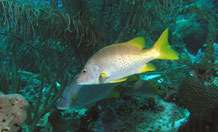Research explains mystery of ocean sediment

(PhysOrg.com) -- New research by an international team of researchers has revealed the previously unidentified role that fish play in the production of sediments in the world's oceans.
It specifically relates to the carbonate sediments that contain critical records of changes in ocean chemistry and climate shifts in the geological past.
The discovery, made by a team of scientists from the UK and US, helps explain the origins of a key component of marine sediments - the fine-grained carbonates, the origins of which are often problematic to resolve.
Published in The Proceedings of the National Academy of Science (PNAS), the study describes the discovery of an entirely new source of marine carbonate and one that has major implications for understanding the origins of the sediments that form ancient limestone and chalk deposits.
Until now it was believed that the fine-grained carbonates that constitute a major component of marine carbonate sediments were derived primarily from either direct precipitation out of seawater or from the breakdown of the skeletons of marine invertebrates and algae.
This study, funded by the UK's Natural Environment Research Council (NERC), shows that large volumes of carbonate crystals are precipitated inside the intestines of marine fish and are then excreted at very high rates, releasing this lesser-known, non-skeletal carbonate into the marine environment.
Although this material comes from the guts of marine fish, it is derived from calcium in the seawater they drink rather than any undigested product of their food.
However, the form and fate of these crystals after excretion by the fish was unknown. The researchers therefore conducted a "needle in a haystack" search, to look for microscopic crystals that are unique to fish within areas that are already rich in carbonate crystals from other organisms.
The study was undertaken in The Bahamas, famous for its white carbonate sands and muds, where the preservation of such crystals in shallow sediments was predicted to be good.
Measurements made on fish that were local to The Bahamas yielded conservative estimates that they produce in excess of 6 million kg of carbonate each year across the region, equivalent to an estimated 14% of its total carbonate mud production.
To reach these findings, the team combined data on regional fish biomass in different marine habitats across The Bahamas with laboratory measurements of the production rates for a range of fish species from this region. These production estimates for fish were then compared against published rates of mud production.
The study reveals that fish guts are a direct source of the most fine-grained carbonate with individual crystals generally less than 30 micrometres (or 0.03 mm) in diameter.
These crystals are also produced in an incredibly diverse array of shapes similar to rugby balls, broccoli florets and dumbbells. Despite their small size, the volumes of carbonate produced by individual fish are so immense that this carbonate has direct relevance to understanding marine carbonate budgets.
Lead author Professor Chris Perry, a marine geoscientist at Manchester Metropolitan University, said: "The recognition that fish can act as major producers of carbonate in the marine environments will be completely unexpected to a large section of the marine science community. Given how much carbonate these fish can produce, the findings also clearly have major implications for our understanding of different sources and sinks of carbonate sediment in the oceans and some exciting implications for understanding where much of the mud in limestones and chalks may derive from".
One of the most interesting issues arising from the study is what it means for our understanding of how marine carbonate sediments accumulate in the first place. The study clearly shows fish to be a unique and novel source of the carbonate sediment in modern marine environments, but the work has equally exciting implications for understanding these processes in the geological record.
Joint corresponding author, Dr. Rod Wilson, a fish biologist at the University of Exeter, said: "An obvious area of future study in this field relates to the geological record and in particular to the role of this process in periods of the Earth's history when ocean chemistry was very different and temperatures considerably warmer. For example, a preliminary study has estimated fish carbonate production under Cretaceous seawater conditions, the time (146-65 million years ago) when large masses of chalk were deposited (famously including the White Cliffs of Dover). These studies, although in their early stages, suggest massive increases in production of this carbonate by fish during this ancient time. Perhaps fish have been a major contributor to these iconic carbonate deposits, in addition to the better known micro-fossils of shelled organisms? However, we are yet to look for direct evidence of this unusual contribution of fish, and we are currently seeking research funds to help answer this intriguing question."
And what about the future? The study finds clear evidence that at present such carbonates can accumulate within the marine environment, at least in warm shallow seas, but the fate of this carbonate under changing oceanographic conditions (especially marine chemistry change) is unclear.
On the one hand, rising sea-surface temperatures should result in higher rates of carbonate production by fish since production increases markedly with temperature. On the other hand, increasing ocean acidity may mean more of this carbonate is dissolved, with potential knock-on effects for ocean carbon cycling and absorption of CO2 from the atmosphere.
Provided by University of Exeter
















